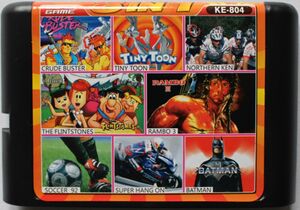Mega Drive unlicensed multi-carts
From Sega Retro
A common practice amongst video game bootleggers is to combine two or more games into one - in the Sega Mega Drive's case, resulting in unlicensed multi-carts. Such an idea is particularly prominent in Asia and South America - often moreso than the act of releasing bootlegs of individual games.
The process is achieved by using high capacity ROM cartridges - with early games such as Tetris shipping on 256kB ROMs, multiple copies can be placed within a 2MB or 4MB ROM with room to spare. Sometimes a simple menu would be programmed to select between the titles, or a soft reset of the console is required to switch games.
Unlike the Nintendo Famicom, in which multi-cart sizes ballooned during the 1990s and 2000s (to the point where manufacturers would (often erroneously) claim a multi-cart contained hundreds of games), it is more common to see Mega Drive multi-carts contain between two and eight games - typically when a cartridge claims to have more than ten, it is a strong indication that games will be repeated, sometimes with very minor changes. Newer Mega Drive games are rarely seen in multi-carts, not only because of their size, but due to tighter security from developers.
Sega have released multiple officially licensed compilations, which save for an expected layer of polish, offer much the same thing.
Contents
Documentation
Thousands of Mega Drive mulit-carts exist, with new ones continuing to be created today. While Sega Retro is attempting to document as many of these cartridges as possible, the volume of releases and the desire for their creators to hide their identities makes this an extremely difficult task.
Simlilar to more traditional bootleg game cartridges, the majority of unlicensed multi-carts originate from the far east, from factories in and around Taiwan, Hong Kong or in more recent years, mainland China. Third-party distributors often design the packaging and are ultimately responsible for selling the product; the same ROM can therefore appear all over the world but in different guises.
Numbered series
Many multi-carts make the documentation process easier by having product code numbers on display (which in turn often double up as the cartridge's "name"). From this we can deduce series based on letter, or similar identifiers. In most cases, it is not known what the letters symbolise.
- 16B series
- 1992 Super series
- A series
- AA series
- AB series
- AC series
- AD series
- B series
- BS series
- BV series
- BVAG series
- CW series
- DM series
- DS series
- DT series
- DY series
- EK series
- EM series
- F series
- FM series
- KC series
- KE series
- KH series
- KT series
- MA series
- MB series
- MC series
- MD series
- MDP series
- NO series
- S series
- SB series
- SC series
- SG series
- SK series
- TH series
- TeleGamestation 2 series
- YE series
- YK series
- ZW series
"Groups"
Many multi-carts lack unique identifiers, and with no ROM dumps or contextual details, can only be judged on general appearance.
Sega Retro has chosen to refer to these cartridge sets as numbered "groups". This is a temporary measure until more information is found. If a number is missing, it means ths group has been identified.
- Mega Drive unlicensed multi-carts (2010s)
- Mega Drive unlicensed multi-carts (MindKids)
- Mega Drive unlicensed multi-carts (Yuswallow)
Others
Multi-carts in South Korea
Several cartridges were created specifically for the South Korean market, often containing Sega Master System or ported MSX games, and menus in Korean.
Master System compilations
A small subset of multi-carts only contain Sega Master System games.
Unsorted
If we can't group by product code, developer, or physical appearance, we can only group by capacity, i.e. how many games are included on each cartridge.
Incomplete
- Main article: Sega Retro:Todo/Multicarts.
The Sega Retro multi-carts project page lists multi-carts whose existence hasn't been proven, or has yet to be documented.



